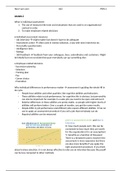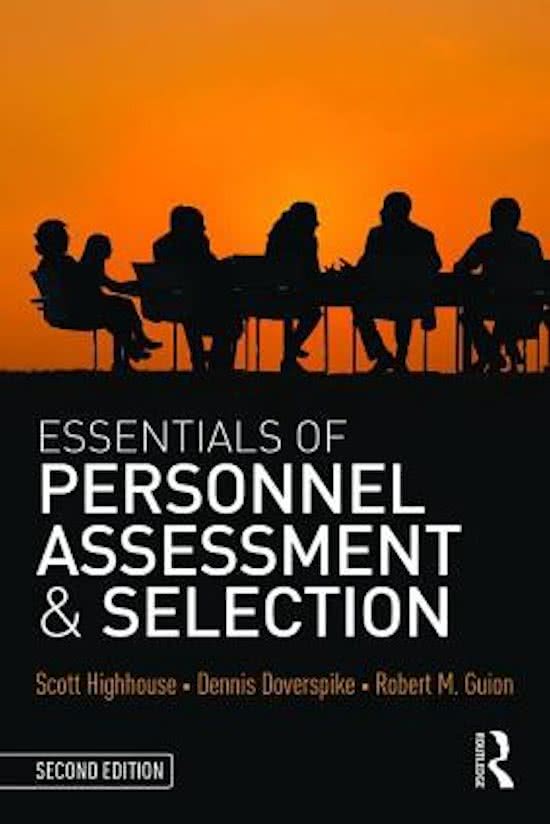Noor van Loon IAO PEW 2
Lecture 1
What is individual assessment:
1. The use of measures like tests and evaluations that are used in an organizational
context in order
2. To make employee related decisions
• Individual assessment measures
- Job interview might matter but doesn’t have to be adequate
- Assessment center often used in trainee selection, a day with tests interviews etc
- Personality questionnaire
- Intelligence tests
- Ratings
- 360 Feedback feedback from your colleagues, boss, subordinates and customers. Might
be helpful but not consistent because everybody can say something else.
• Employee related decisions
- Succession planning
- Selection
- Training plan
- Pay
- Career choice
- Promotion
Why individual differences in performance matter assessment is guiding the whole HR in
de cycle.
- People have abilities and other qualities, like cognitive abilities and behaviors.
- These abilities relate to job performance, for cognitive this is obvious, but personality
can also be important for example in a sales job you need to be open and extrovert
- Relative differences in these abilities are pretty stable, so people with higher levels of
abilities will perform better. Over a couple of months, you get the same results.
- People differ in job performance and different jobs require different abilities. It has no
use to apply an assessment procedure if you sell a job that everybody can do
- Required abilities can be measured
green is assessment center and blue is
interview.
X= how much people earn; this can be
connected to how much they are worth
for the organization (it is an assumption)
Y= benefits as a function of thousand
There is a breakeven point, however the
assessment is more expensive but there
are also more benefits if you apply the
right assessment procedure. If you think
about trainee selection, it is not always effective to only use an interview because the payoff
can be less compared to other methods.
,Noor van Loon IAO PEW 2
It might be that the assessment procedures that are used are more applicable to men than
to women which leads to less women in the labor market.
Adequate individual assessment in organizations
• Pay off of personnel decisions is relevant for organization and individuals and groups of
individuals
• You can earn a lot of money by using the right measure, but the measure should also be
fair in its use!
So the use of assessment measures should be:
Reliable, valid, practical in their use, yielding the right pay off, fair to all involved and
non-leading to discriminatory effects for groups of people
This involves several theoretical, methodological, and practical considerations
Individual assessment is based on two premises:
1. Fundamental assumptions about assessment
Needed before we can measure anything
2. A basic model to understand:
Predictor – criterion relationships in IAO
Constructs - measures relationships in IAO
Fundamental assumptions about individual assessment
a) People have abilities
b) People differ in any given ability
c) Relative differences in ability remain pretty much the same
d) Different jobs require different abilities
e) The required abilities can be measured
Validity & Reliability
Right upper: performance, you want to say
something about it
Left upper: abilities, you use those to make a
prediction on performance, you can measure
those. Obvious but not done that often in
organizations
two distinctions
Upper: construct derives its
scientific value from the
shared meaning for different
people; They are not
observable, you can talk
about them and people know
,Noor van Loon IAO PEW 2
what you mean but you can’t see them, it is an abstract notion about how somebody
is doing it in his or her job. Definition is really important, i.e when you talk about
cognitive abilities it might be handy that people know what it is. Building blocks of
scientific theories.
Measures; are observable, they represent constructs; used to test theories.
predictor: what you are using to
predict the aim
criterion: what should be predicted by
the predictor
Criterion constructs
- Overall performance= abstract notion
- Citizenship behavior= the things you do that are not described in a contract, outside
the job description. Comes with adaptive behavior, whether people can adapt to
changing situations
- Customer oriented= might be ‘being on time and structured” in the one company or
“be happy” in another company
Predictor constructs
- Intelligence= how to divide intelligence, what subconstructs are there?
- Personality= do you want someone who is disciplined or someone who is outgoing?
You should know what people are talking about
Criterion measures
- Bars
- 360 degree rating= ratings by colleagues, peers or boss which gives an overall view of
what others think of you
predictive validity. you can only compute
a correlation coefficient between
measures. Requires you to compare test
scores to performance on some other
, Noor van Loon IAO PEW 2
measure in the future. Will be lower because you have to wait until people show their
performance. Until that nothing is measured= practical/statistical problem. E.g. if you take
an intelligence test because you think intelligence is an important predictor for performance
then you still have to wait for the actual performance to see whether your intelligence test
measured what you wanted it to measure.
Construct validity. How well is the measure covering your construct? If you say you have a
certain part of the construct, then you miss other parts of the constructs. If you count how
many times a customer smiles than you have a very lousy example of construct validity of
customer friendliness. Friendliness namely consists of more subconstructs and only smiling
does not measure the whole thing.
Concurrent validity refers to the degree in which the scores on a measurement are related to
other scores on other measurements that have already been established as valid.
When we want to correlate, we are
encountering problems because some
things are just an estimation. BUT we can
also use literature. You can give a rough
estimation about some jobs for example
but there is still a difference between a
salesperson in a big company and a small
family company.
you can use this, but you still have to use
your brains. Intelligence is important but
maybe it doesn’t matter in this job that
much.
You would be asked to improve the selection procedure for a sales job and decide to include
an online sales person test (a kind of personality test). After some period, you want to
research the validity of this assessment tool for good job performance.
• What would the design of this validation study look like?
• How would restriction of range influence the findings of the validation study?
Validation research
1. Analyze the job
2. Choose a criterion
3. Form predictive hypotheses





